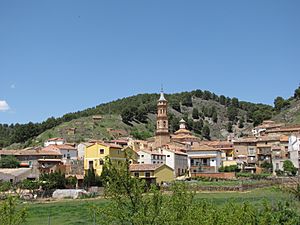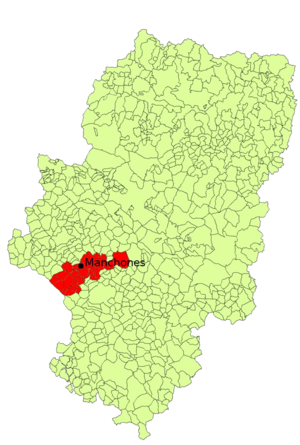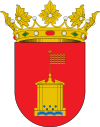Manchones facts for kids
Quick facts for kids
Manchones
|
|||
|---|---|---|---|
|
Municipality and village
|
|||

view of Manchones from the south
|
|||
|
|||

Location of Machones within Campo de Daroca in Aragon
|
|||
| Country | Spain | ||
| Autonomous community | Aragon | ||
| Province | Zaragoza | ||
| Comarca | Campo de Daroca | ||
| Area | |||
| • Total | 27 km2 (10 sq mi) | ||
| Elevation | 756 m (2,480 ft) | ||
| Population
(2018)
|
|||
| • Total | 98 | ||
| • Density | 3.63/km2 (9.40/sq mi) | ||
| Time zone | UTC+1 (CET) | ||
| • Summer (DST) | UTC+2 (CEST) | ||
| Postcode |
50366
|
||
| Area code(s) | 976 | ||
Manchones is a small town in Spain. It's located in the Aragon region, within the Zaragoza province. In 2018, about 98 people lived there. The town is part of the Campo de Daroca area. It sits about 6 kilometers (3.7 miles) northwest of Daroca. The Jiloca River flows nearby to the west.
The main church in Manchones is named after the Conversion of St Paul. You can still see parts of old defensive walls there. These walls were built during the Reconquista. This was a time when Alfonso the Battler, the king of Aragon, fought to open a path to Valencia from Zaragoza.
Contents
Where is Manchones Located?
Manchones is a small town found at the bottom of a hill. It is in the valley of the Jiloca River. This valley lies between the cities of Calatayud and Daroca. The town is on an old travel route. This route connected the central plateau of Spain (Meseta Central) with the Ebro River and the coast of Levante. This important route was used even in Roman times.
A Look at Manchones' History
People have found very old remains in the Manchones area. These finds show that people lived here long ago. There is also some proof of Celtiberian settlements. The name of the town, Manchones, might come from mancusos. These were gold coins used in Aragon during the 11th century.
In 1152, a man named Diego López de Lobera received the castle of Manchones. He had served King Alfonso the Battler during the Reconquista. Later, in 1248, King Jaime I of Aragon made Manchones free. It no longer depended on Daroca. Instead, it became part of the Community of Daroca Villages. This group of villages lasted until 1838.
Fun Festivals in Manchones
Manchones has several exciting festivals each year.
Winter Celebrations
The town celebrates the feasts of St. Vincent and St. Paul. These festivities happen on the last weekend of January. This time also matches the feast of St. Valero in Zaragoza.
Summer Festivities
The celebrations for San Roque usually last for five days. They end on August 16, which is the saint's feast day. On August 15, the town has a special pilgrimage. People also enjoy a big feast in the town square.
Important Buildings in Town
Manchones has some interesting old buildings.
The Parish Church
The parish church is called the Church of the Conversion of St Paul. It was built in the 18th century. It stands on the site of an even older medieval church. The church was repaired and made new in 2004–2005. Inside, there is a chapel dedicated to the Virgen del Pilar. This chapel has a beautiful baroque reredos (an altarpiece) from the late 17th century. A wooden crucifix from the 15th century is kept in the sacristy.
Defensive Walls
You can still see parts of old defensive walls and towers. These remains show that Manchones was once part of a defense system. This system helped protect the nearby town of Daroca.
Famous People from Manchones
Several notable people have come from Manchones:
- Jesús Ángel Bernal Julián – He is an actor. He also started the Teatro de la Estación in Zaragoza.
- Antonio Palacios Rodrigo – He was a bullfighter. He lived from 1932 to 1958.
- José Luis Roca Millán – Born in 1934, he was once the president of the Spanish Football Federation.
See also
 In Spanish: Manchones para niños
In Spanish: Manchones para niños




